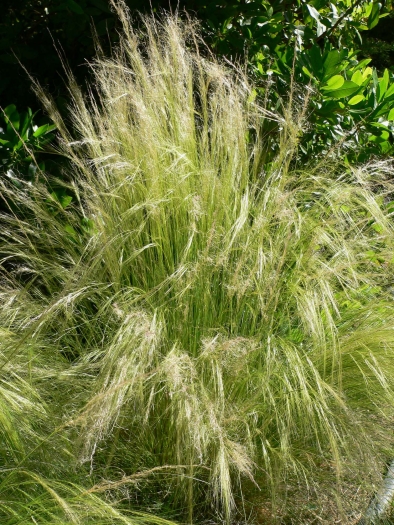Giant Feather Grass
(Nassella gigantea)
Giant Feather Grass (Nassella gigantea)
/
/

Stan Shebs
CC BY-SA 3.0
Image By:
Stan Shebs
Recorded By:
Copyright:
CC BY-SA 3.0
Copyright Notice:
Photo by: Stan Shebs | License Type: CC BY-SA 3.0 | License URL: https://creativecommons.org/licenses/by-sa/3.0 | Uploader: Stan Shebs | Publisher: Wikimedia Commons | Title: Nassella_tenuissima.jpg | Notes: ;Name:Nepeta mussinii ;Family:Lamiaceae Image no. 5 Permission granted to use under GFDL by Kurt Stueber Source: [http://www.biolib.de www.biolib.de] {{GFDL}} |

Estimated Native Range
Summary
Nassella gigantea, commonly known as Giant Feather Grass, is an evergreen perennial grass native to the grasslands and open woodlands of Southern South America. It reaches a typical height of 4-6 feet (1.2-1.8 meters) and a width of 2 feet (0.6 meters). This species is characterized by its tall, arching, feathery inflorescences that sway gracefully in the breeze, adding texture and movement to the garden. The flowers emerge green but mature to a golden hue, providing visual interest from late spring into autumn.
Giant Feather Grass is valued for its low maintenance requirements and its ability to add a naturalistic, meadow-like quality to landscapes. It is often used in ornamental grass borders, as an accent plant in mixed borders, or for erosion control on slopes. This grass prefers full sun exposure and can tolerate a range of soil types, provided they have good drainage. While it is drought-tolerant once established, it benefits from medium amounts of water during its growing season. Gardeners should be aware that in some regions, Nassella gigantea can self-seed and become invasive, so it is important to monitor and manage its spread to prevent unwanted naturalization.CC BY-SA 4.0
Giant Feather Grass is valued for its low maintenance requirements and its ability to add a naturalistic, meadow-like quality to landscapes. It is often used in ornamental grass borders, as an accent plant in mixed borders, or for erosion control on slopes. This grass prefers full sun exposure and can tolerate a range of soil types, provided they have good drainage. While it is drought-tolerant once established, it benefits from medium amounts of water during its growing season. Gardeners should be aware that in some regions, Nassella gigantea can self-seed and become invasive, so it is important to monitor and manage its spread to prevent unwanted naturalization.CC BY-SA 4.0
Plant Description
- Plant Type: Grass
- Height: 4-6 feet
- Width: 1-2 feet
- Growth Rate: Moderate
- Flower Color: N/A
- Flowering Season: Summer
- Leaf Retention: Evergreen
Growth Requirements
- Sun: Full Sun
- Water: Medium
- Drainage: Medium
Common Uses
Butterfly Garden, Drought Tolerant, Low Maintenance
Natural Habitat
Grasslands and open woodlands of Southern South America
Other Names
Common Names:
Scientific Names: , Nassella gigantea, Nassella exserta, Urachne gigantea, Nassella melanocarpa, Nassella pugae, Nassella aemulans, Nassella exserta var. exserta, Nassella fuscescens, Urachne aemulans
GBIF Accepted Name: Nassella gigantea (Steud.) Muñoz-Schick